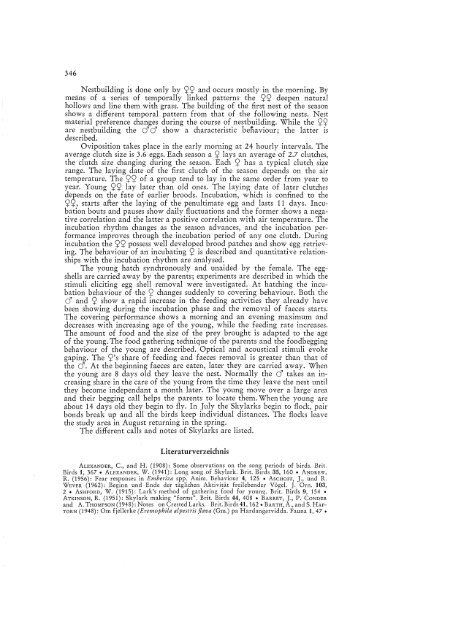Das Verhalten der Feldlerche - KOPS
Das Verhalten der Feldlerche - KOPS
Das Verhalten der Feldlerche - KOPS
Sie wollen auch ein ePaper? Erhöhen Sie die Reichweite Ihrer Titel.
YUMPU macht aus Druck-PDFs automatisch weboptimierte ePaper, die Google liebt.
346<br />
Nestbuilding is done only by S?S? and occurs mostly in the morning. By<br />
means of aseries of temporally linked patterns the S?S? deepen natural<br />
hollows and line them with grass. The building of the first nest of the season<br />
shows a different temporal pattern from that of the following nests. Nest<br />
material preference changes during the course of nestbuilding. While the S?S?<br />
are nestbuilding the 0' 0' show a characteristic benaviour; the latter is<br />
described.<br />
Oviposition takes place in the early morning at 24 hourly intervals. The<br />
average dutch size is 3.6 eggs. Each season a S? lays an average of 2.7 dutches,<br />
the dutch size changing during the season. Each S? has a typical dutch size<br />
range. The laying date of the first dutch of the season depends on the air<br />
temperature. The S?S? of a group tend to lay in the same or<strong>der</strong> from year to<br />
year. Young S?S? lay later than old ones. The laying date of later dutches<br />
depends on the fate of earlier broods. Incubation, which is confined to the<br />
S?S?, starts after the laying of the penultimate egg and lasts 11 days. Incubation<br />
bouts and pauses show daily fluctuations and the former shows a negative<br />
correlation and the latter a positive correlation with air temperature. The<br />
incubation rhythm changes as the season advances, and the incubation performance<br />
improves through the incubation period of any one clutch. During<br />
incubation the S?S? possess well developed brood patches and show egg retrieving.<br />
The behaviour of an incubating S? is described and quantitative relationships<br />
with the incubation rhythm are analysed.<br />
The young hatch synchronously and unaided by the female. The eggshells<br />
are carried away by the parents; experiments are described in which the<br />
stimuli eliciting egg shell removal were investigated. At hatching the incubation<br />
behaviour of the S? changes suddenly to covering behaviour. Both thc<br />
0' and S? show a rapid increase in the feeding activities they al ready havc<br />
been showing during the incubation phase and the removal of faeces starts.<br />
The covering performance shows a morning and an evening maximum and<br />
deCl'cases with increasing age of the young, while the feeding rate increascs.<br />
The amount of food and the size of the prey brought is adapted to the age<br />
of the young. The food gathering technique of the parents and the foodbegging<br />
behaviour of the young are described. Optical and acoustical stimuli evoke<br />
gaping. The S?'s share of feeding and faeces removal is greater than that of<br />
the 0'. At the beginning faeces are eaten, later they are carried away. When<br />
the young are 8 days old they leave the nest. Normally the 0' takes an increasing<br />
share in the care of the young from the time they leave the nest until<br />
they become independant a month later. The young move over a large arca<br />
and their begging call helps the parents to locate them. When the young are<br />
about 14 days old they begin to fly. In July the Skylarks begin to flock, pair<br />
bonds break up and all the birds keep individual distances. The flocks leave<br />
the study area in August returning in the spring.<br />
The different calls and notes of Skylarks are listed.<br />
Literaturverzeichnis<br />
ALEXANDER, c., and H. (1908): Some observations on the song periods of birds. ßrit.<br />
Birds 1, 367. ALEXANDER, W. (1941): Long song of Skylark. Brit. Birds 35,160 • ANDREW,<br />
R. (1956): Fear responses in Embel'iza spp. Anim. ßehaviour 4, 125 • ASCHOFF, ]., und R.<br />
WEVER (1962): ßeginn und Ende <strong>der</strong> täglichen Aktivität freileben<strong>der</strong> Vögel. J. Orn. 103,<br />
2 • ASHFORD, W. (1915): Lark's method of gathering food for young. Brit. ßirds 9, 154 •<br />
ATKINSON, R. (1951): Skylark making "forms". Brit. Birds 44,408 • BARRET, ]., P. CONDER<br />
and A. THOMPSON (1948): Notes on Crested Larks. Brit. Birds 41,162. BARTH, A., and S. HAF<br />
TORN (1948): Om fjellerke (Eremophila alpestris (lava (Gm.) pa Hardangervidda. Fauna 1,47 •

















